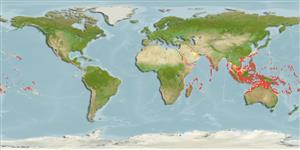Common names from other countries
Environment: milieu / climate zone / depth range / distribution range
экология
морской ассоциированный с рифами; немигрирующий; пределы глубины 0 - 100 m (Ref. 9710), usually 0 - 20 m (Ref. 92868). Tropical; 30°N - 24°S
Indo-Pacific: common and wide-ranging, from the Western Indian Ocean to Japan and Pacific Ocean islands to as far as the Marquesas.
Size / Вес / Возраст
Maturity: Lm ? range ? - ? cm
Max length : 25.0 cm TL самец/пол неопределен; (Ref. 48635); common length : 18.0 cm TL самец/пол неопределен; (Ref. 30573)
колючие лучи спинного плавника (общее число) : 8 - 9; членистые (мягкие) лучи спинного плавника (общее число) : 11 - 12; колючие лучи анального плавника: 0; членистые (мягкие) лучи анального плавника: 12. Body and head mottled with dark brown and buff; fin rays with dark brown or black spots; dark brown saddle blotch on top of caudal peduncle (Ref. 4315). Least interorbital width going 3.8-7.2 times in diameter of eye. Base of lower opercular spine concealed by scales. Anterior 1-3, usually 3, lateral line scales bearing a small spine. Iris lappet bearing short branches with bifurcate tips.
Inhabits sand areas adjacent to coral reefs (Ref. 9790). Seldom noticed for it buries itself in the sand (often partially). Usually in small groups (Ref. 48635). Feeds on crustaceans, crabs and prawns, also on fishes.
Life cycle and mating behavior
Maturities | размножение | Spawnings | Egg(s) | Fecundities | личинки
Randall, J.E., G.R. Allen and R.C. Steene, 1990. Fishes of the Great Barrier Reef and Coral Sea. University of Hawaii Press, Honolulu, Hawaii. 506 p. (Ref. 2334)
Статус Красного Списка МСОП (Ref. 130435)
CITES (Ref. 128078)
Not Evaluated
Угроза для людей
Harmless
Использование человеком
рыболовство: рыболовство как средство для существования
дополнительная информация
инструменты
Специальные отчеты
Скачать в формате XML
ресурсы в Интернет
Estimates based on models
Preferred temperature (Ref.
115969): 25.4 - 29, mean 27.9 (based on 980 cells).
Phylogenetic diversity index (Ref.
82804): PD
50 = 0.5010 [Uniqueness, from 0.5 = low to 2.0 = high].
Bayesian length-weight: a=0.00589 (0.00346 - 0.01003), b=3.09 (2.93 - 3.25), in cm Total Length, based on LWR estimates for this species & (Sub)family-body (Ref.
93245).
Trophic level (Ref.
69278): 3.8 ±0.63 se; based on food items.
устойчивость к внешним воздействиям (Ref.
120179): высокий, минимальное время удвоения популяции до 15 месяцев (Preliminary K or Fecundity.).
Fishing Vulnerability (Ref.
59153): Low vulnerability (15 of 100).
